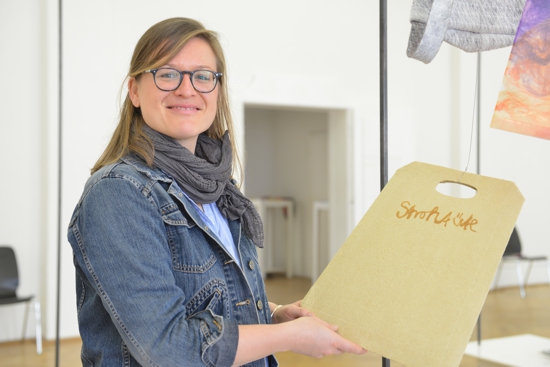Christin Mannewitz, Conceptual Textile Design (M.A.) at the Burg Giebichenstein University of Art and Design has examined the potential of plant waste for the development of new materials. In 2015 Christin developed a first attempt of compostable bags from agricultural waste such as straw, rhubarb and asparagus peelings. We interviewed her about her research experience.
Can you describe us briefly what the bag you developed is made of?
My paper bag is made of different vegetable remains. These include peelings of rhubarb, asparagus as well as straw.
Why did you decide to develop a bag made from plant waste?
In the framework of a study project, I wanted to develop a bag made from renewable resources. This bag should degrade itself after use without polluting the environment. It can be an alternative to conventional plastic bags, which are produced from limited fossil raw materials and rot with harmful consequences for humans and nature. My challenge was to use a feedstock which is not already used for industrial scale production and to make a pleasant looking product.
What is the advantage of your bag compared to a common bag made for instance from recycled paper?
The advantage of my bag is that raw material used come from vegetable residues, which don’t have to be produced but accumulate as a result of agricultural production, unlike in the paper industry, where forest areas are cut down for the production of pulp.
How much straw, rhubarb and asparagus peelings do you need to produce one bag?
I don’t have an exact measure, because my prototype has been handcrafted.
What could this bag be used for?
It can be used just a regular paper bag. The bag works particularly well on communication purposes, because it is a straight forward way to showcase the material used to manufacture it.

If regularly used how long will this bag normally last?
The bag and its material are handmade but have been manufactured according to industrial standards. I believe that a paper bag made from crop residues can have the same durability as a conventional paper bag, although, I’m quite sure that better durability results can be achieved.
How can it be disposed of?
The bag can be disposed of in the compost without hesitation. Also the glue and the print of the bag are made from natural raw materials and rot without environmental impact.
What was the biggest challenge you had to face when conducting this research?
A design study is a protected environment in which ideas are allowed to grow without having to satisfy industrial standards. This gives a great advantage because it allows the freedom to experiment and innovate. Industry operates according to its own requirements and when it comes to establishing the industrial manufacturability of such a bag specific requirements arise, like usability of the bag, availability of raw materials and availability of suitable machines for production. It was a real challenge to find the right answers to these issues but thanks to the scholarship of the ScienceCampus Halle – Plant-Based Bioeconomy, I was able to contact different people from industry and academia to address them.
Why did you decide to study a subject related to renewable resources?
I studied textile design. At first glance, such an artistic subject doesn’t seem to have much to do with renewable resources at first sight. But in the world of textiles the raw materials are getting more and more important. The focus of this project was explicitly on sustainability, which gave me the opportunity to expand my knowledge in this area by experimenting these new materials.
What is your favourite bio-based product (besides your own)?
Fibre cement as material is very exciting. There are some interesting projects in this direction.
Author
Erik Lohse
Source
AllThings.Bio, press release, 2018-04-20.
Supplier
Burg Giebichenstein Kunsthochschule Halle
Share
Renewable Carbon News – Daily Newsletter
Subscribe to our daily email newsletter – the world's leading newsletter on renewable materials and chemicals










